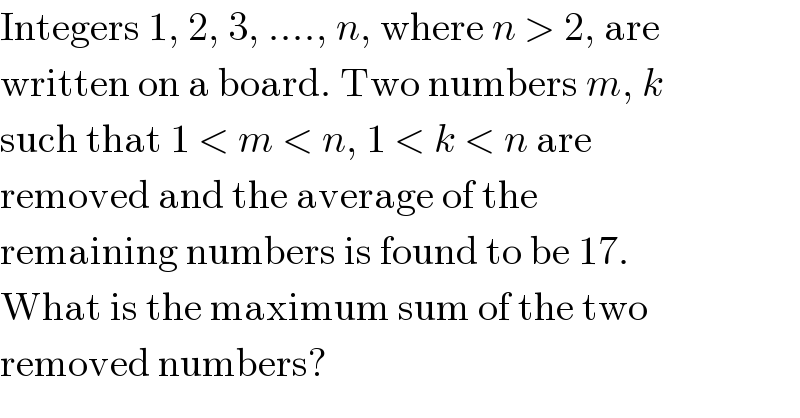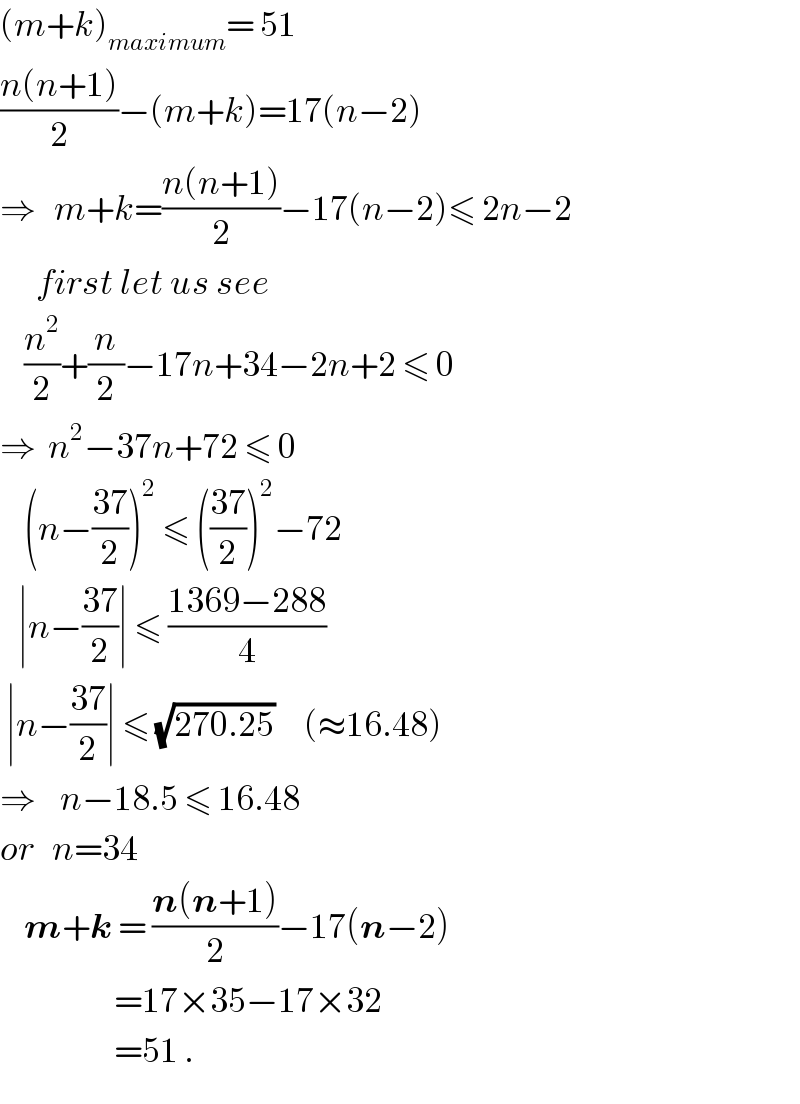Question Number 20693 by Tinkutara last updated on 31/Aug/17

$$\mathrm{Integers}\:\mathrm{1},\:\mathrm{2},\:\mathrm{3},\:….,\:{n},\:\mathrm{where}\:{n}\:>\:\mathrm{2},\:\mathrm{are} \\ $$$$\mathrm{written}\:\mathrm{on}\:\mathrm{a}\:\mathrm{board}.\:\mathrm{Two}\:\mathrm{numbers}\:{m},\:{k} \\ $$$$\mathrm{such}\:\mathrm{that}\:\mathrm{1}\:<\:{m}\:<\:{n},\:\mathrm{1}\:<\:{k}\:<\:{n}\:\mathrm{are} \\ $$$$\mathrm{removed}\:\mathrm{and}\:\mathrm{the}\:\mathrm{average}\:\mathrm{of}\:\mathrm{the} \\ $$$$\mathrm{remaining}\:\mathrm{numbers}\:\mathrm{is}\:\mathrm{found}\:\mathrm{to}\:\mathrm{be}\:\mathrm{17}. \\ $$$$\mathrm{What}\:\mathrm{is}\:\mathrm{the}\:\mathrm{maximum}\:\mathrm{sum}\:\mathrm{of}\:\mathrm{the}\:\mathrm{two} \\ $$$$\mathrm{removed}\:\mathrm{numbers}? \\ $$
Answered by ajfour last updated on 31/Aug/17

$$\left({m}+{k}\right)_{{maximum}} =\:\mathrm{51} \\ $$$$\frac{{n}\left({n}+\mathrm{1}\right)}{\mathrm{2}}−\left({m}+{k}\right)=\mathrm{17}\left({n}−\mathrm{2}\right) \\ $$$$\Rightarrow\:\:\:{m}+{k}=\frac{{n}\left({n}+\mathrm{1}\right)}{\mathrm{2}}−\mathrm{17}\left({n}−\mathrm{2}\right)\leqslant\:\mathrm{2}{n}−\mathrm{2} \\ $$$$\:\:\:\:\:\:{first}\:{let}\:{us}\:{see} \\ $$$$\:\:\:\:\frac{{n}^{\mathrm{2}} }{\mathrm{2}}+\frac{{n}}{\mathrm{2}}−\mathrm{17}{n}+\mathrm{34}−\mathrm{2}{n}+\mathrm{2}\:\leqslant\:\mathrm{0} \\ $$$$\Rightarrow\:\:{n}^{\mathrm{2}} −\mathrm{37}{n}+\mathrm{72}\:\leqslant\:\mathrm{0} \\ $$$$\:\:\:\:\left({n}−\frac{\mathrm{37}}{\mathrm{2}}\right)^{\mathrm{2}} \:\leqslant\:\left(\frac{\mathrm{37}}{\mathrm{2}}\right)^{\mathrm{2}} −\mathrm{72} \\ $$$$\:\:\:\mid{n}−\frac{\mathrm{37}}{\mathrm{2}}\mid\:\leqslant\:\frac{\mathrm{1369}−\mathrm{288}}{\mathrm{4}} \\ $$$$\:\mid{n}−\frac{\mathrm{37}}{\mathrm{2}}\mid\:\leqslant\:\sqrt{\mathrm{270}.\mathrm{25}}\:\:\:\:\:\left(\approx\mathrm{16}.\mathrm{48}\right) \\ $$$$\Rightarrow\:\:\:\:{n}−\mathrm{18}.\mathrm{5}\:\leqslant\:\mathrm{16}.\mathrm{48} \\ $$$${or}\:\:\:{n}=\mathrm{34} \\ $$$$\:\:\:\:\boldsymbol{{m}}+\boldsymbol{{k}}\:=\:\frac{\boldsymbol{{n}}\left(\boldsymbol{{n}}+\mathrm{1}\right)}{\mathrm{2}}−\mathrm{17}\left(\boldsymbol{{n}}−\mathrm{2}\right) \\ $$$$\:\:\:\:\:\:\:\:\:\:\:\:\:\:\:\:\:\:\:=\mathrm{17}×\mathrm{35}−\mathrm{17}×\mathrm{32} \\ $$$$\:\:\:\:\:\:\:\:\:\:\:\:\:\:\:\:\:\:\:=\mathrm{51}\:. \\ $$
Commented by Tinkutara last updated on 01/Sep/17

$$\mathrm{Thank}\:\mathrm{you}\:\mathrm{very}\:\mathrm{much}\:\mathrm{Sir}! \\ $$
